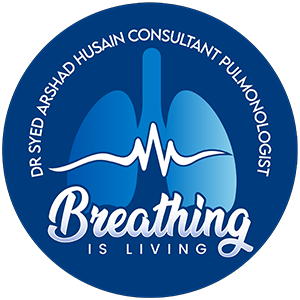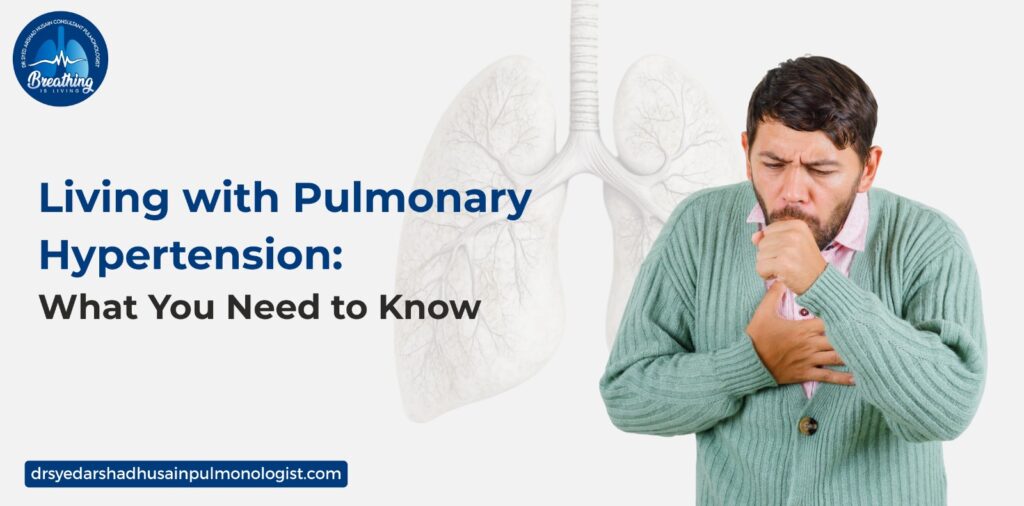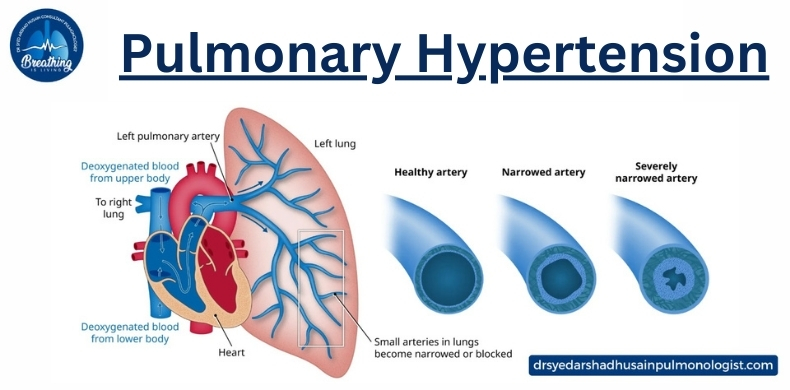Pulmonary Hypertension or PH is a very serious disease where the blood pressure in the arteries of the lungs becomes dangerously high. This high blood pressure puts extra strain on the heart, which makes it difficult to pump blood through the lungs. Over time, it becomes more serious and has a big chance of causing heart failure and reducing oxygen supply to the body. That’s why understanding pulmonary hypertension can help you prevent the condition in the early phase.
What Causes Pulmonary Hypertension?
Pulmonary Hypertension occurs when blood vessels in the lungs become narrowed, blocked, or stiffened, increasing pressure in the pulmonary arteries. Key causes include:
- Idiopathic PH:Unknown cause but may be linked to genetic factors.
- Left Heart Disease: Conditions like heart failure or valve disorders can lead to increased lung pressure.
- Lung Diseases: COPD, interstitial lung disease, and sleep apnea contribute to PH.
- Blood Clots (Pulmonary Embolism): Blockages in lung arteries can increase pressure.
- Autoimmune Diseases: Lupus, scleroderma, and rheumatoid arthritis may lead to PH.
- Liver Disease: Cirrhosis and portal hypertension can affect lung blood flow.
Common Symptoms of Pulmonary Hypertension
PH symptoms develop gradually but worsen over time. Early detection is crucial for better management.
- Shortness of Breath: Especially during physical activity.
- Fatigue & Weakness: The heart works harder to pump blood, causing exhaustion.
- Chest Pain or Pressure: A sign of increased strain on the heart.
- Swelling in Legs & Abdomen: Fluid retention due to poor circulation.
- Dizziness or Fainting: Indication of reduced oxygen flow to the brain.
- Bluish Lips & Skin (Cyanosis): Lack of oxygen-rich blood in circulation.
If you experience these symptoms, Consult a pulmonologist immediately.
Types of Pulmonary Hypertension
Pulmonary Hypertension is categorized into different groups based on underlying causes:
- Pulmonary Arterial Hypertension (PAH): A rare, severe form with unknown or genetic causes.
- PH Due to Left Heart Disease: The most common type linked to heart failure or valve disease.
- PH Due to Lung Conditions: COPD, Pulmonary fibrosis, and sleep apnea contribute to this category.
- Chronic Thromboembolic PH (CTEPH): Caused by long-term blood clots in the lungs.
- PH Due to Other Conditions: Linked to autoimmune diseases, liver disease, and metabolic disorders.
Related Blogs: Pulmonary Fibrosis Every Patient Should Know
How is Pulmonary Hypertension Diagnosed?
To confirm PH, doctors use a combination of tests:
- Echocardiogram: Measures heart function and lung artery pressure.
- Right Heart Catheterization: The gold standard for measuring pulmonary artery pressure.
- Electrocardiogram (ECG): Checks for heart strain or abnormalities.
- Chest X-ray & CT Scan: Helps detect lung and heart-related issues.
- Pulmonary Function Tests: Help evaluate lung capacity and function.
Treatment Options for Pulmonary Hypertension
1. Medications to Manage Symptoms
- Vasodilators: Open narrowed blood vessels (Sildenafil, Epoprostenol).
- Endothelin Receptor Antagonists: Reduce artery narrowing (Bosentan, Ambrisentan).
- Diuretics: Help reduce fluid buildup in the body.
- Blood Thinners: Prevent clot-related complications.
2. Lifestyle Changes for Better Heart & Lung Health
- Regular Exercise: Light physical activity improves circulation.
- Healthy Diet: Low-sodium, high-fiber diets support heart health.
- Quit Smoking & Alcohol: Reduces lung damage and strain on the heart.
- Manage Stress: Lowers blood pressure and prevents flare-ups.
3. Advanced Treatment Options
- Oxygen Therapy: Helps those with low oxygen levels.
- Lung or Heart Transplant: Considered for severe, untreatable cases.
- Balloon Pulmonary Angioplasty (BPA): A newer treatment for CTEPH cases.
Related Blog: Breathing Troubles? Here’s When to See a Pulmonologist
Complications of Pulmonary Hypertension
Without proper treatment, PH can lead to severe health risks:
- Right Heart Failure: The heart weakens over time.
- Arrhythmias (Irregular Heartbeat): Can cause sudden cardiac arrest.
- Blood Clots in the Lungs: Increase strain on the heart.
- Bleeding in the Lungs: Can lead to coughing up blood.
Preventing Pulmonary Hypertension
While some causes of PH are unavoidable, preventive steps can reduce risks:
- Control Blood Pressure & Cholesterol: Reduces strain on heart and lungs.
- Treat Underlying Lung & Heart Conditions: Early management prevents complications.
- Stay Active & Maintain a Healthy Weight: Reduces cardiovascular stress.
- Avoid High Altitudes: Low oxygen levels can worsen symptoms.
- Regular Check-Ups: Essential for those at risk of PH.
When to See a Doctor?
Seek immediate medical attention if you experience:
- Severe breathlessness even at rest.
- Persistent chest pain or dizziness.
- Swelling in legs or bluish skin discoloration.
Final Thoughts
Pulmonary Hypertension is a serious yet manageable condition when detected early. With proper treatment, lifestyle adjustments, and ongoing medical care, patients can improve their quality of life and reduce complications. If you have risk factors for PH, consult a healthcare professional such as Prof. Dr. Syed Arshad Husain (the best pulmonologist in Dubai) for early diagnosis and prevention strategies.



